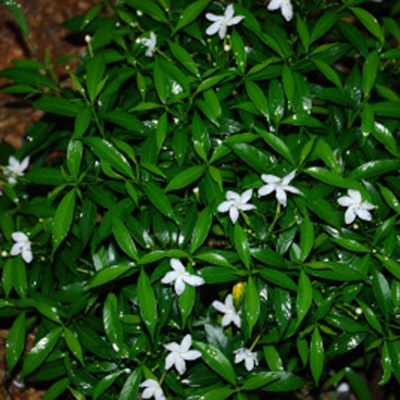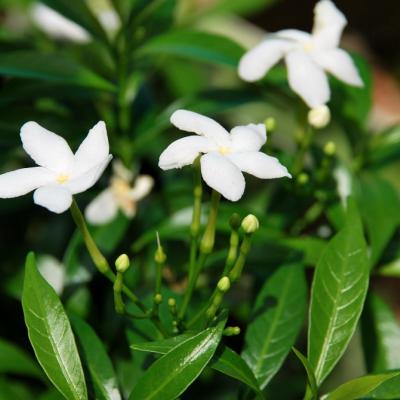Apocynaceae-Tabernaemontana-divaricata
Classification
- Botanical Family : Apocynaceae
- Genus : Tabernaemontana
- Epithet : divaricata
- German Family Name: Hundsgiftgewächse
- English Name: Gardenia Crape Jasmine
- Thai Name: พุดศุภโชค
- Thai Phonetic: pud sup schok
- Author: R.Br. ex Roem. & Schult.
Water Requirements
Plant Type
Light Requirements
Cultivation
Tabernaemontana divaricata is an evergreen, bushy plant, with a hemispherical crown and glossy green foliage that looks attractive all year round. Has branched out considerably. The bush grows up between 0.30 m and 3 m height.
The small white flowers with 5 petals, delicately scented and arranged in zymes. They bloom several times a year.
Is very good effect when several plants are planted in rows or between higher growing plants. The many small white flowers make the bush to an eye catcher. Is also popular as potted plants.
The plant grows best in partial shade, tolerates full sun as well. Only shade let the leaves be brown and the flower formation does not occur.
Keep soil constantly moist, but avoid waterlogging. Mature plants tolerates 2-3 days dry soil.
Prune to take the form you wish. This is a fairly bushy shrub on its own, and pruning will often make it even more bushy.
The juice of this plant is poisonous. It causes skin irritation in contact with skin. If consumed the raw parts of the plant it causes irritation in the mouth, lips, throat and tongue.
Propagation: Hardwood and semi-hardwood cuttings take pretty well. Cut a 10 cm section and remove all the upper leaves. Dip fresh cut stem in rooting hormone and place in a cutting soil in medium light and high humidity. Roots usually form after 2-6 weeks. Keep the soil moist, not overwatering.
Tabernaemontana divaricata ist eine immergrüne, buschig wachsende Pflanze mit einer halbkugelförmigen Krone und glänzend grünen Blättern, die das ganze Jahr über attraktiv aussieht. Ist stark verästelt. Der Busch wächst zwischen 0,30 m und 3 m hoch.
Die kleinen weißen Blüten mit 5 Blütenblättern duften zart und sind in Zymen angeordnet. Sie blühen mehrmals jährlich.
Kommt sehr gut zur Wirkung, wenn mehrere Exemplare in Reihe gepflanzt werden oder zwischen höher wachsende Pflanzen. Die vielen kleinen weißen Blüten machen aus dem Busch einen echten Hingucker. Ist auch als Topfpflanze beliebt.
Die Pflanze gedeiht am besten im Halbschatten, toleriert aber auch volle Sonne. Nur Schatten lässt die Blätter braun werden und die Blütenbildung bleibt aus.
Erde ständig feucht halten, aber Staunässe vermeiden. Erwachsene Pflanzen kommen schon mal 2-3 Tage mit abgetrocknetem Boden aus.
Der Busch kann in jede gewünschte Form verschnitten werden. Ein regelmäßiger Verschnitt regt die Verästelung an und lässt die Pflanze noch buschiger werden.
Der Saft dieser Pflanze ist giftig. Er verursacht bei Hautkontakt Hautreizungen. Bei Einnahme bewirkt er Reizungen im Mund, auf Lippen, im Rachen und auf der Zunge.
Vermehrung: durch verholzte oder halb verholzte Stecklinge, die mindestens 10 cm lang sein sollten. Die Stecklinge können gleich an Ort und Stelle gepflanzt werden, wenn die erste Zeit für ausreichend Halbschatten gesorgt ist. Die Wurzeln sollten sich dann innerhalb von 2-6 Wochen gebildet haben. Erde nur feucht halten, nicht nass.


